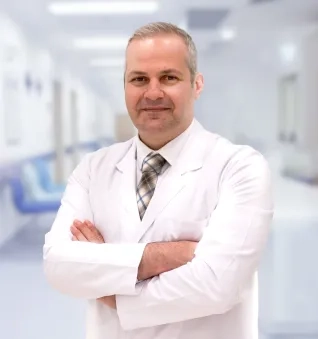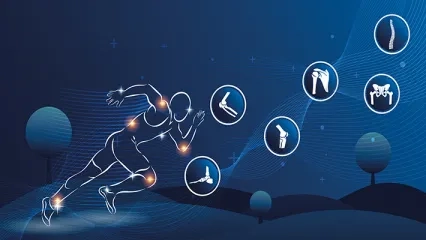Alo Yeditepe
Alo Yeditepe
Knee Pain
Why Does Front Knee Pain Occur?
Experiencing pain in the front of the knee after climbing stairs or squatting is a common occurrence for many individuals in their daily lives. However, Orthopedics and Traumatology Specialist Prof. Dr. Budak Akman warns that since the pain may not significantly impact the person's life, individuals might delay consulting a doctor. "If the pain in the front of the knee doesn't improve within a few days and there is difficulty in moving the knee, it is essential to seek medical attention without delay," said Prof. Dr. Akman. Our expert particularly pointed out that these pains can be effectively managed with intra-articular injections, which have become more widely used in recent years.
While knee pain in people of all ages is common, it is more frequently encountered in middle-aged individuals. Although not often considered very serious, the pain in the front of the knee can be a problem that reduces the patient's quality of life. Orthopedics and Traumatology Specialist mentions that patients may have difficulty describing this pain accurately. "Especially when situations arise where the knee starts to bend, such as climbing up and down stairs, squatting, or walking up and down hills, and if the pain persists for 2-3 days, it is crucial to consult a doctor," said the specialist.
When Is Front Knee Pain Considered Dangerous?
Describing knee pain that occurs without any trauma and begins in a vague manner, Yeditepe University Kozyatağı Hospital Orthopedics and Traumatology Specialist said, "In this case, the patient feels the pain, but since it does not significantly affect their life, they may not consult a doctor. As time passes, the pain becomes a bit more persistent and dominant. Therefore, when the patient reaches the doctor, the pain has intensified, and some time has passed."
Our specialist, reminding that there are various reasons for this condition, issued the following warnings: "Pain caused by simple strain should resolve within 2-3 days. In cases where the pain persists beyond this period, it is important for the patient not to seek their own solution and to consult a doctor. It should not be forgotten that delay can lead to the pain becoming permanent and dominant."
Why Do Front Knee Pains Occur in Old Age?
Our expert, reminding that as age advances, there is an increase in degeneration in the joints and the joint structure of a 60-year-old is not the same as that of a 30-year-old, said, "As we age, degeneration begins in the cartilage, meniscus, and ligament structures in the joints. There is a difference between the front knee problem of a 30-year-old and a 60-year-old. As age progresses, calcification also begins. The problem takes on a different dimension. If the pain caused by movement, such as squatting and rising, performing religious rituals, climbing up and down stairs, or standing for long periods due to the profession, is felt in the joint each time and occupies the person's mind, it should not be overlooked."
"Sometimes, just resting may be sufficient, while various nonsteroidal drugs, pain relievers, ice applications, and physiotherapy can provide relief for a significant number of our patients. In addition to these, intra-articular injections, which we commonly use nowadays, are available. Intra-articular injections are among the frequently used methods since they yield quite successful results in alleviating the patient's symptoms."
Treatment Methods for Front Knee Pain
Our expert, indicating that there are different alternatives based on the patient's condition and the problem in intra-articular injections, provided the following information on the subject: "One of these is cortisone injections. Although cortisone injections do not have a healing property, they have a relieving and pain-reducing effect on the patient's symptoms. Another type of injection is hyaluronic acid. This is similar to the fluid in the knee joint. Another one that is widely heard and curious in public is PRP (Platelet-Rich Plasma) and stem cells. These are blood products obtained from the patient's own blood. We benefit from the regenerative properties of PRP and stem cells, which means they can help heal damaged tissue. There is another type of injection that has emerged recently, which is hydrogel treatment. In cases where surgery is required but the patient cannot undergo surgery for various reasons or is not suitable for anesthesia, hydrogel treatment may be a suitable option. The ones we use more frequently in practice are hyaluronic acid and blood products similar to PRP. With these treatments, we can generally successfully alleviate pain in our patients."
About
Faculty and Year of Graduation:
Uludağ University faculty of Medicine, 2003
”
See Also
- What are Hip Joint Diseases? Causes and Treatment
- Robotic Hip Replacement Surgery
- Things to Consider When Walking in Snowy Weather
- Ergonomics in Automobiles Prevents Accidents
- Don't Underestimate Bone Pain That Doesn't Make You Sleep and Doesn't Relieve With Medication
- What Causes Hip Pain? How Does Hip Pain Go Away?
- What is a Stress Fracture? How to Treat Stress Fracture?
- Biopsy for Bone and Soft Tissue Tumors
Alo Yeditepe




